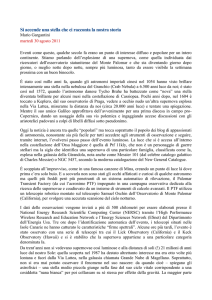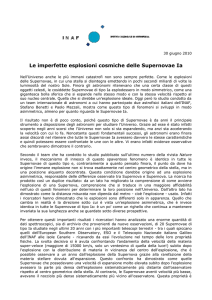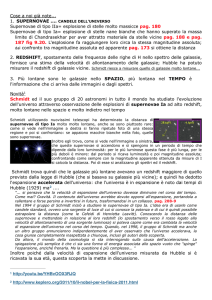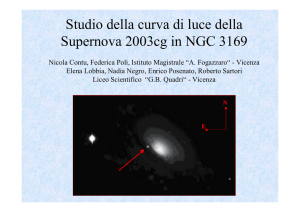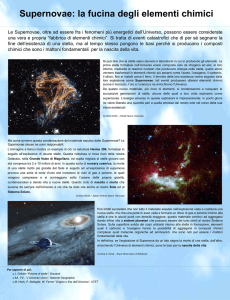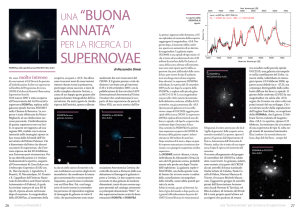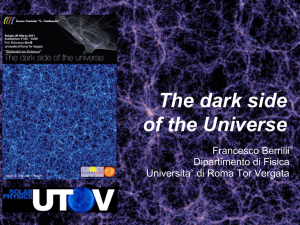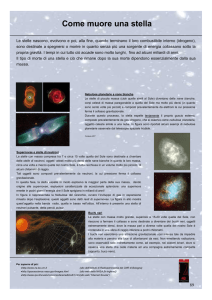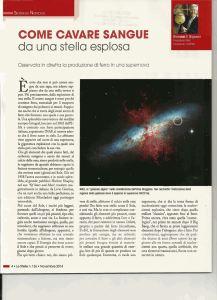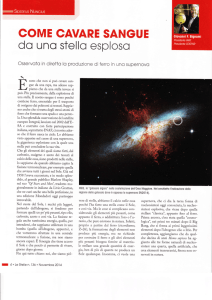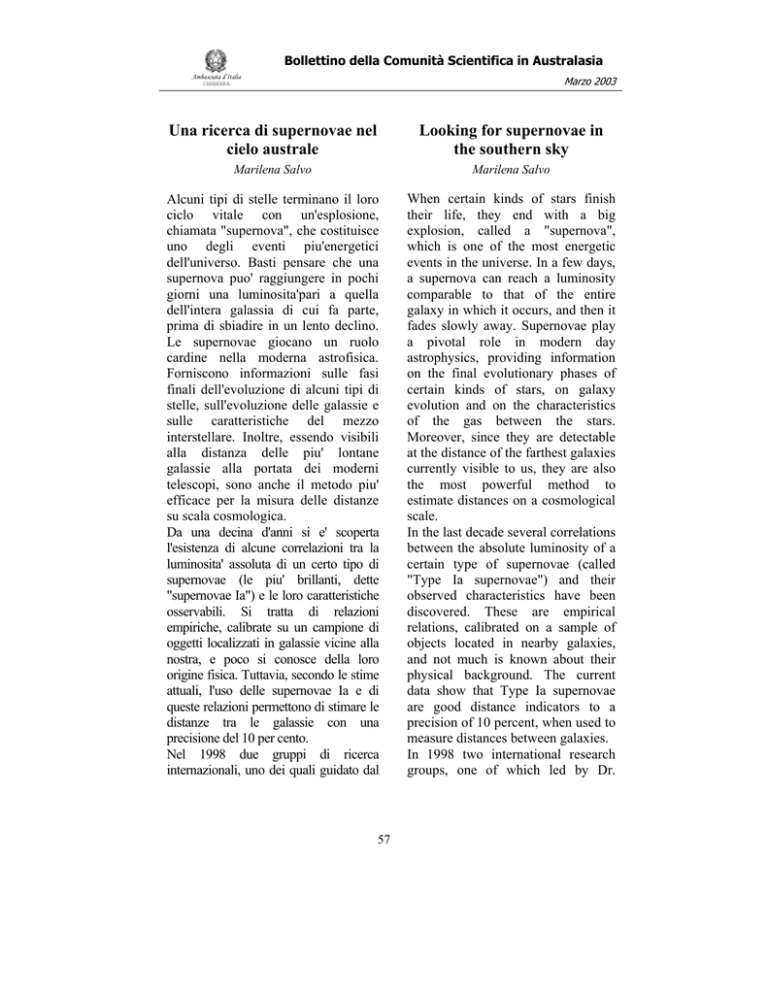
Bollettino della Comunità Scientifica in Australasia
Ambasciata d’Italia
Marzo 2003
CANBERRA
Una ricerca di supernovae nel
cielo australe
Looking for supernovae in
the southern sky
Marilena Salvo
Marilena Salvo
Alcuni tipi di stelle terminano il loro
ciclo vitale con un'esplosione,
chiamata "supernova", che costituisce
uno degli eventi piu'energetici
dell'universo. Basti pensare che una
supernova puo' raggiungere in pochi
giorni una luminosita'pari a quella
dell'intera galassia di cui fa parte,
prima di sbiadire in un lento declino.
Le supernovae giocano un ruolo
cardine nella moderna astrofisica.
Forniscono informazioni sulle fasi
finali dell'evoluzione di alcuni tipi di
stelle, sull'evoluzione delle galassie e
sulle caratteristiche del mezzo
interstellare. Inoltre, essendo visibili
alla distanza delle piu' lontane
galassie alla portata dei moderni
telescopi, sono anche il metodo piu'
efficace per la misura delle distanze
su scala cosmologica.
Da una decina d'anni si e' scoperta
l'esistenza di alcune correlazioni tra la
luminosita' assoluta di un certo tipo di
supernovae (le piu' brillanti, dette
"supernovae Ia") e le loro caratteristiche
osservabili. Si tratta di relazioni
empiriche, calibrate su un campione di
oggetti localizzati in galassie vicine alla
nostra, e poco si conosce della loro
origine fisica. Tuttavia, secondo le stime
attuali, l'uso delle supernovae Ia e di
queste relazioni permettono di stimare le
distanze tra le galassie con una
precisione del 10 per cento.
Nel 1998 due gruppi di ricerca
internazionali, uno dei quali guidato dal
When certain kinds of stars finish
their life, they end with a big
explosion, called a "supernova",
which is one of the most energetic
events in the universe. In a few days,
a supernova can reach a luminosity
comparable to that of the entire
galaxy in which it occurs, and then it
fades slowly away. Supernovae play
a pivotal role in modern day
astrophysics, providing information
on the final evolutionary phases of
certain kinds of stars, on galaxy
evolution and on the characteristics
of the gas between the stars.
Moreover, since they are detectable
at the distance of the farthest galaxies
currently visible to us, they are also
the most powerful method to
estimate distances on a cosmological
scale.
In the last decade several correlations
between the absolute luminosity of a
certain type of supernovae (called
"Type Ia supernovae") and their
observed characteristics have been
discovered. These are empirical
relations, calibrated on a sample of
objects located in nearby galaxies,
and not much is known about their
physical background. The current
data show that Type Ia supernovae
are good distance indicators to a
precision of 10 percent, when used to
measure distances between galaxies.
In 1998 two international research
groups, one of which led by Dr.
57
Bollettino della Comunità Scientifica in Australasia
Ambasciata d’Italia
Marzo 2003
CANBERRA
Dott. Brian P. Schmidt dell'Australian
National University di Canberra, hanno
utilizzato le supernovae Ia per
investigare le caratteristiche su vasta
scala dell'universo. Entrambi i gruppi
hanno scoperto, indipendentemente, che
l'universo sembra in espansione
accelerata. Questo risultato ha suscitato
un grande scalpore tra gli scienziati e il
pubblico, e sembra confermato da altri
esperimenti
scientifici
che
non
prevedono l'utilizzo delle supernovae.
Tuttavia, finche' l'origine delle relazioni
alla base dell'uso delle supernovae Ia
come indicatori di distanza rimarra'poco
conosciuta, non sara' possibile essere
certi della validita' di queste relazioni
anche nel caso di oggetti che esplodono
in galassie molto lontane da noi.
Guardare lontano nell'universo vuol dire
anche guardare nel suo passato, e non
possiamo escludere che supernovae Ia
esplose a miliardi di anni luce da noi
presentino caratteristiche diverse da
quelle degli oggetti a noi piu' vicini, per
esempio a causa di un processo
evolutivo delle stelle che danno origine a
esplosioni di questo tipo.
Brian P. Schmidt from the Australian
National University, used Type Ia
supernovae to investigate the large
scale characteristics of the universe.
Both
groups
discovered
independently that the universe
seems to be accelerating in its
expansion. This breakthrough caused
a sensation among both scientists and
the general public, and seems to be
supported by other non related
experiments. However, until we
understand the origin of the relations
on which the use of Type Ia
supernovae as distance indicators is
based, we can not be certain that
these relations are valid even in the
case of objects that explode in very
distant galaxies. To look far away in
the universe also means to look back
in its past, and we cannot rule out the
possibility that Type Ia supernovae
billions of light years away have
different characteristics from the
closer ones, e.g. due to evolution of
their progenitor stars.
Per chiarire questo punto, gli
astronomi stanno cercando di
incrementare il numero di supernovae
ben studiate e di migliorare i modelli
teorici che permettono di riprodurne
le
caratteristiche
osservate.
Nell'emisfero nord sono attivi dei
programmi di ricerca automatica di
supernovae e di monitoraggio degli
eventi scoperti durante le varie fasi
della loro evoluzione. Nell'emisfero
australe, l'unica ricerca automatica di
supernovae al momento attiva e' il
risultato di una collaborazione tra
To clarify this point, astronomers are
trying to increase the number of well
studied supernovae and to improve
the theoretical models that allow to
reproduce
their
observed
characteristics. Automated supernova
searches and monitoring programs
are currently active in the northern
hemisphere.
In
the
southern
hemisphere,
the
only
active
automated supernova search is a
collaboration between the Australian
National
University
and
the
University of the New South Wales.
58
Bollettino della Comunità Scientifica in Australasia
Ambasciata d’Italia
Marzo 2003
CANBERRA
l'Australian National University e
l'Universita' del New South Wales. I
telescopi utilizzati sono l'Automated
Patrol Telescope (APT), un piccolo
strumento a grande campo, e un
telescopio da 2.3m di diametro, uno
dei piu' grandi sul territorio
australiano. Entrambi sono situati
all'Osservatorio di Siding Spring, nei
pressi di Coonabarabran, NSW. Il
software per le osservazioni e la
riduzione automatica dei dati e'stato
recentemente installato sul computer
che controlla l'APT, e dovrebbe
permettere la scoperta di decine di
supernovae all'anno. Le osservazioni
sono gia' in corso. Il telescopio da
2.3m e' gia' dall'anno scorso
impegnato nel monitoraggio di eventi
di supernova scoperti da altri
ricercatori.
The telescopes used for this project
are the Automated Patrol Telescope
(APT),
a
small,
wide-field
instrument, and the ANU 2.3m
diameter telescope, one of the largest
in Australia. They are both located at
Siding Spring Observatory, near
Coonabarabran, NSW. Automated
observing procedures, and the
software pipelines to enable the
discovery of many supernovae per
year have been recently installed at
the APT. Observations are currently
ongoing. Since last year the 2.3m
telescope has been monitoring a
number of important supernova
events
discovered
by
other
researchers.
Gli scienziati dell'Australian National
University sono entrati a far parte, da
alcuni mesi, di un Network per lo studio
delle supernovae Ia, in rete sul sito
http://www.mpa-garching.mpg.de/~rtn/.
Tale Network e'finanziato dalla
Comunita'Europea e coinvolge tutti i
maggiori istituti scientifici europei
dove si svolge ricerca sulle
supernovae, tra i quali anche
l'Osservatorio
Astronomico
di
Padova. Occasione d'incontro per i
membri europei ed australiani del
Network sara' l'Assemblea Generale
dell'Unione
Astronomica
Internazionale, che avra' luogo a
Sydney tra il 13 e il 26 luglio 2002.
E' la seconda volta che l'Australia
ospita questo prestigioso evento,
organizzato ogni due anni in una sede
diversa, e a cui partecipano astronomi
In the past few months, the scientists
at the Australian National University
have become part of a Network to
study Type Ia supernovae, online at
http://www.mpa-garching.mpg.de/~rtn/.
This Network is funded by the
European Community and involves
all the major European institutions
where supernova research is carried
on. Among the others, Padua
Observatory. The General Assembly
of the International Astronomical
Union, which will be held in Sydney
in July 13-26, will give the European
and Australian partners of the
Network a chance to meet.
This is the second time that Australia
hosts this important event, which is
held every second year in a different
city and whose participants are
astronomers from all over the world.
59
Bollettino della Comunità Scientifica in Australasia
Ambasciata d’Italia
Marzo 2003
CANBERRA
da tutto il mondo. All'Assemblea
Generale di Sydney sono attese
almeno duemila persone, impegnate
nella ricerca in tutti i campi
dell'astrofisica.
At least two thousand researchers
involved
in
all
aspects
of
astrophysics
are
expected
to
participate in the General Assembly
in Sydney this year.
Dott.ssa Marilena Salvo
Research School of Astronomy and
Astrophysics
The Australian National University
Mt.Stromlo Observatory, Cotter Rd, 2611
Weston, ACT, Australia
Ph: +61 2 6125 6712
Fax: +61 2 6125 0260
Web: http://www.mso.anu.edu.au/~salvo/
Email: [email protected]
60

